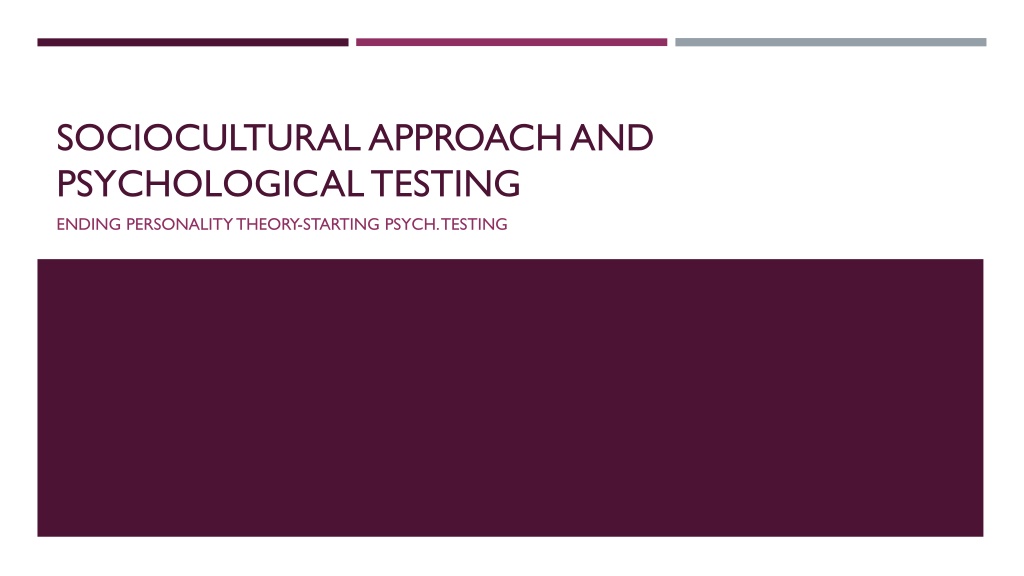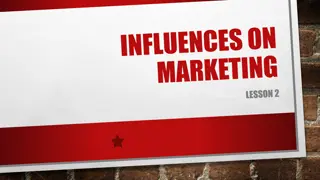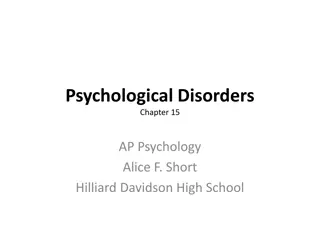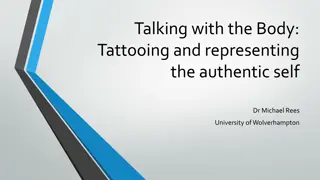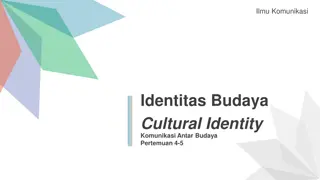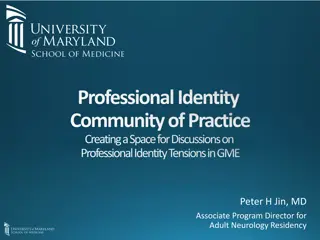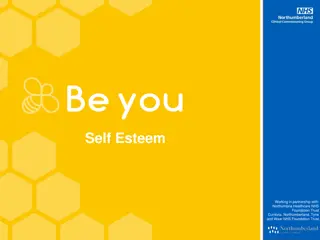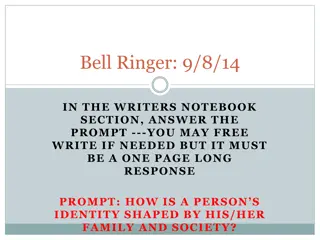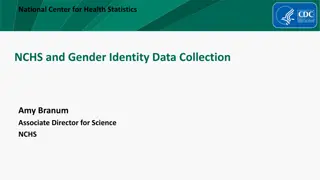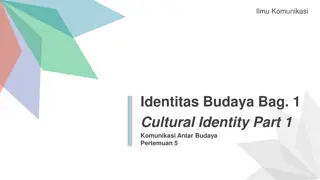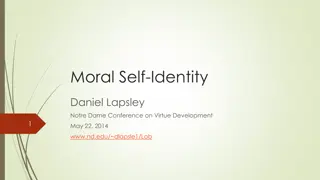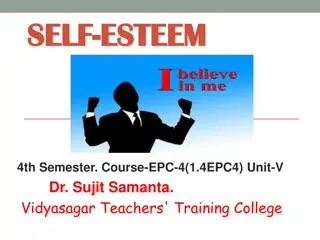Sociocultural Factors Influencing Self-Concept and Identity Formation
Explore the impact of sociocultural factors on self-esteem, economic background, gender, and race in shaping one's sense of self. Delve into the concepts of Individualism and Collectivism, analyzing how different parts of the world prioritize these values. Reflect on the importance of teaching children to share and achieve individually, discussing the pros and cons of each approach. Engage in a discussion about the Twin Oaks community, characters embodying Individualism, and the Self-Concept in relation to these cultural paradigms.
Download Presentation

Please find below an Image/Link to download the presentation.
The content on the website is provided AS IS for your information and personal use only. It may not be sold, licensed, or shared on other websites without obtaining consent from the author. Download presentation by click this link. If you encounter any issues during the download, it is possible that the publisher has removed the file from their server.
E N D
Presentation Transcript
SOCIOCULTURAL APPROACH AND PSYCHOLOGICAL TESTING ENDING PERSONALITY THEORY-STARTING PSYCH. TESTING
HOMEWORK: SHORT ESSAY Write a 1-2 page short essay (INCLUDE A THESIS AND BREAK DOWN INTO PARAGRAPHS) in which you analyze how sociocultural factors impact who you are and your sense of self To do this, answer three of the following questions: How is your self esteem influenced by how society sees you? How does your economic background play a role in your sense of self? How does gender impact who you are? What role does race play in your life?
WARM UP What do you think is the difference between Individualism and Collectivism (based on the root word)? What parts of the world do you think are more focused on Individualism? What parts of the world do you think are more focused on Collectivism?
LEARNING OBJECTIVES Analyze the Sociocultural Approach Interpret Individualism, Collectivism, and Acculturation Build Connections to own lives
THE SOCIOCULTURAL APPROACH Sociocultural Approach: Emphasis is on ethnicity, gender and culture and how they influence personality Individualism: People define themselves based on their own personal identity, goals, traits, and jobs Collectivism: People define themselves based on social groups, relationships, families, and religions Do you think people in the United States focus more on Individualism or Collectivism?
DISCUSSION What is more important to teach out children? To share, and be part of the group, or to achieve themselves? What are good and bad things about each approach First write down your answer (1 paragraph) and then we will discuss
CHECK FOR UNDERSTANDING Was the Twin Oaks community that we watched a video on more about Individualism or Collectivism? Write down three examples of characters in movies, TV shows, or books that are based around Individualism What is the Self-Concept? How would this be impacted by Individualism and Collectivism?
ACCULTURATION Acculturation: The process of adapting to a new or different culture
MY BIG FAT GREEK WEDDING https://www.youtube.com/watch?v=RfYF3TAST5E How is the future husband experiencing Acculturation? Does Acculturation mean that you have to change? Why or why not? Who do you think generally has an easier time with the process of acculturation? Parents or Children? Why?
DANCES WITH WOLVES https://www.youtube.com/watch?v=uc8NMbrW7mI How do you know Kevin Costner is going through Acculturation? What Sociocultural factors impact this process of Acculturation? How is Collectivism and Individualism part of Acculturation in this case?
MILLION DOLLAR ARM https://www.youtube.com/watch?v=lEtNIoPxcq8 How are the Indian boys going through Acculturation? What impact do you think Acculturation is having upon the boys? What factors might make it easier for someone to go through Acculturation?
IMAGERY Using Imagery (pictures, graphics, drawing, etc.), show what it is like to go through Acculturation Use at least 10 Images This can be based on your own experiences with Acculturation or what you think it must be like to go through Acculturation Make sure you show the connection between psychology and Acculturation
START ESSAY THIS IS IN-CLASS TIME TO START YOUR ESSAY!!!
HOMEWORK: SHORT ESSAY Write a 1-2 page short essay (INCLUDE A THESIS AND BREAK DOWN INTO PARAGRAPHS) in which you analyze how sociocultural factors impact who you are and your sense of self To do this, answer three of the following questions: How is your self esteem influenced by how society sees you? How does your economic background play a role in your sense of self? How does gender impact who you are? What role does race play in your life?
WARM UP What does Psychological Testing mean to you? What could be three good things about Psychological Testing? What could be three bad things about Psychological Testing?
LEARNING OBJECTIVES Analyze Psychological Testing in Society Interpret how Reliability, Validity and Cognitive Restructuring impacts Test-Taking Build Connections to own lives
PSYCHOLOGICAL TESTING Purpose of Psych. Testing: Assess abilities, feelings, attitudes, and behaviors Examples of Psych. Tests: 1. Standardized Tests: Administered and scored the same way every time -What are some examples of standardized tests that you are already familiar with (think of ones we studied in class) 2. Behavior Rating Scale- Used to measure behavior in different settings (example=classroom) 3. Self-Reports- People are asked to report their own attitudes, feelings, and behaviors
RELIABILITY AND VALIDITY Reliability-The level of consistency in terms of the results of a test Validity-The extent to which a test measures what it is supposed to measure and predict what it is supposed to predict What problems have we already discussed in terms of reliability and validity when it comes to many standardized tests? What factors might impact the reliability and validity of a test?
VALIDITY SCALE Validity Scale- Questions the test-giver asks so they can know how honest the test-taker is being with their answers Pretend you are a cop, pediatrician, or principal come up with a list of ten questions to form a Validity Scale Partner up with someone near you and have them answer the questions on your Validity Scale
ROLE PLAYING: THE TEST-GIVER I need three volunteers Each volunteer= different test-giver Based on the way they give directions, write down 5 words you are feeling about taking their test
SCENARIO: TEST DIRECTIONS Each Test Giver will be giving these directions and telling you the following things for taking the test: 1. You need to take out # 2 Pencils to fill out your Scantron 2. The time to take the test is _________________ 3. The test-giver will tell you about how they feel about the test 4. The test-giver will tell what will happen based on the results of the test
CHECK FOR UNDERSTANDING What role does the Test-giver play in terms of how the Test- taker is impacted? How does the Test-giver impact validity and reliability of the test? What role does anxiety and nervousness play in taking tests? Do you get nervous and anxious when you take tests? Is this normal? Why or why not? Is test-anxiety always a bad thing? Why or why not?
REDUCING TEST ANXIETY Write down five ways that you can reduce your own test anxiety
FACTORS THAT REDUCE TEST ANXIETY -BE PREPARED: STUDY THE MATERIAL -Don t Cram : Don t try to learn all the material the night before -Plan a regular studying schedule (Exp: Each night I will spend 1 hour studying for my Psych. Test) -Overlearn: Review the material over and over again, even after you think you mastered it -Think helpful thoughts: Replace negative thoughts with positive thoughts
COGNITIVE RESTRUCTURING Cognitive Restructuring: Changing the thoughts one has in a particular situation Pair up with a partner and write a dialogue in which one of you represents negative thoughts related to a test and the other partner represents positive thoughts related to a test Your dialogue needs to have ten negative thoughts and ten positive thoughts Include thoughts that you have before, during, and after a test
WARM UP Is test anxiety good, bad, or both? Why? Identify three strategies that you can use to reduce test anxiety
TESTING VOCABULARY Norms-Established standards of performance that evaluate the results of tests Norm Group- Group of test takers who represent those who are similar to the intended people taking the test Achievement Tests- Measure people s skills and knowledge in academic areas Aptitude Tests- Determine how fit someone is for a field of work or study Vocational Interest Inventories- Determine whether someone s interests are similar to other people in the same line of work Forced-Choice Format-Test-taker is forced to choose answers
TEST SCENARIOS-GALLERY WALK 1. Write a scenario in which someone takes a test, BUT DON T write down what kind of test it is! EXP: Bob takes the MCAT to try to get into Medical School 2. Write one scenario for each type of test we just looked at 3. For each scenario, come up with three Testing Norms 4. After you have written four scenarios with three Testing Norms for each, analyze the scenarios of 5 classmates and write down which test best fits for each scenario 5. You should have two pieces of paper when you re finished: a. Your sheet of scenarios with Testing Norms for each scenario b. Analysis sheet of the scenarios of 5 classmates
PERSONALITY TESTS MMPI-2: Diagnose Psychological Disorders Rorschach Inkblot Test: Diagnose Personality Disorders CPI: Designed to Measure Personality Traits Thematic Apperception Test (TAT): Allows people s needs and values to emerge from stories they tell
YOU ARE THE THERAPISTS-GROUPS OF 5 4 Therapists: Each Therapist has to grade, interpret, and analyze the answers the patient individually One Patient Based on the answers given by the patient and the analysis of the therapists, come up with an evaluation of the patient Based on this evaluation, are these tests reliable and valid? Which tests are more reliable and valid than other tests and why?
ANSWERS I see a face in the card I see a scary face in the card Things look like they're whirling around in the card It looks like we're looking down on people or something in the card I see a mask in the card I see a flower in the card I see some sexual imagery in the card
ANSWERS It looks like two double-amputees dancing It looks like the coast of Italy after an atom bomb attack, only mirrored It looks like a pair of one-legged cannibals fighting over a victim I love pudding It looks like an RLFP DNA test result, with the phenotypes split It looks like Satan's head, the white part in the middle (can't you see it?) It looks like smudges, or maybe an inkblot
ANSWERS I see Satan's eyes, filled with an evil, burning hatred for my soul I see a fluffy bunny-rabbit I see a big naughty shape at the top, in the center It looks like a guy that was hit by a bullet-train going 5 million miles an hour This blot doesn't really look like anything to me. Can we have some lunch? It looks like a Tele-Tubby (maybe 'Po'?) that was run over by a Sherman Tank It looks like you just threw ink on a paper and then folded it
